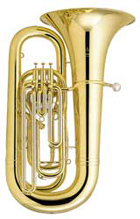 Although it is unlike them in almost every way, this fine noble instrument, easily the deepest member of the brass section, is usually associated with the trombones. It also is similar to the horn and the trumpet in that it makes use of valves – 4 in number, and these provide a complete chromatic scale based on the tubas fundamental note.
Although it is unlike them in almost every way, this fine noble instrument, easily the deepest member of the brass section, is usually associated with the trombones. It also is similar to the horn and the trumpet in that it makes use of valves – 4 in number, and these provide a complete chromatic scale based on the tubas fundamental note.
Probably the first major work to make use fully of the tuba was Berlioz “Symphonie Fantastique” which was originally intended to feature two ophicleides but was later changed by Berlioz to include two tubas in their place after the composer had become aware of the newly invented instrument.
There are at least four ‘bass tubas’ which can be found commonly used and they vary in size and weight:
- The Tuba in F – a fairly lightweight instrument long considered to be the standard orchestral bass tuba throughout Europe.
- The Tuba in E-flat – this is the standard tuba in the UK often used by orchestral players because of its more sonorous lower range but very frequently found in band setups.
- The Tuba in C – this is the default tuba used in American orchestras.
- The Great Double B-flat Tuba – almost exclusively used in brass bands merely because the other band instruments are usually based on a B-flat tonality.
The tenor tuba in B-flat is quite different to the above bass tubas and corresponds much more to the euphonium — the instrument so beloved of the military bands. This instrument is pitched an octave above the great double B-flat tuba.
The main function of the tuba is to provide a strong reliable bass to the brass section and can often best be used to double the bass trombone at the octave below. When blown softly, the tuba combines admirably well with the horns and could almost be viewed as a fifth member of the horn family although it must be stressed that this would only be possible in very quiet chordal passages. When played loudly, the tubas tone is very different to that of the horn.
Tuba parts are generally written in the bass clef and in concert pitch.
See also the Wagner Tuba